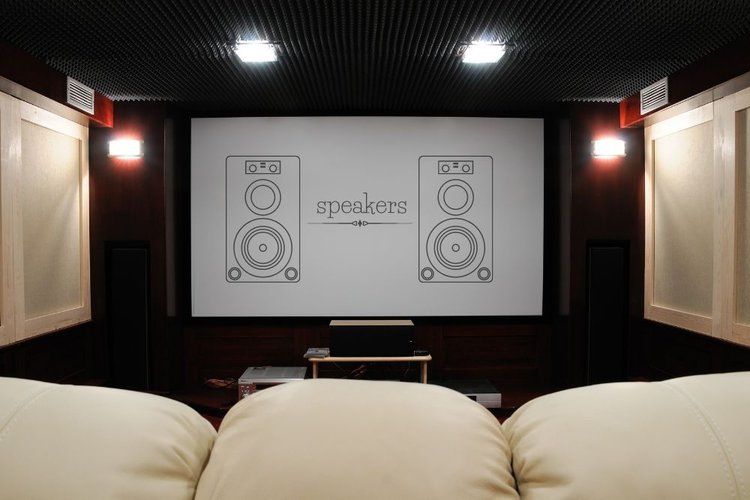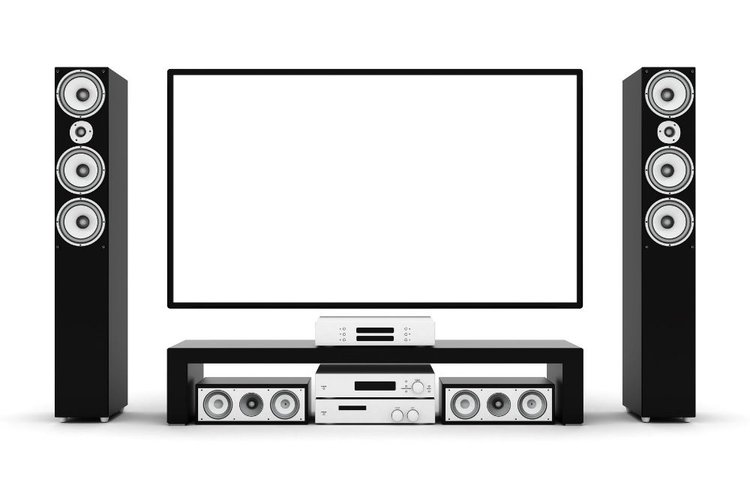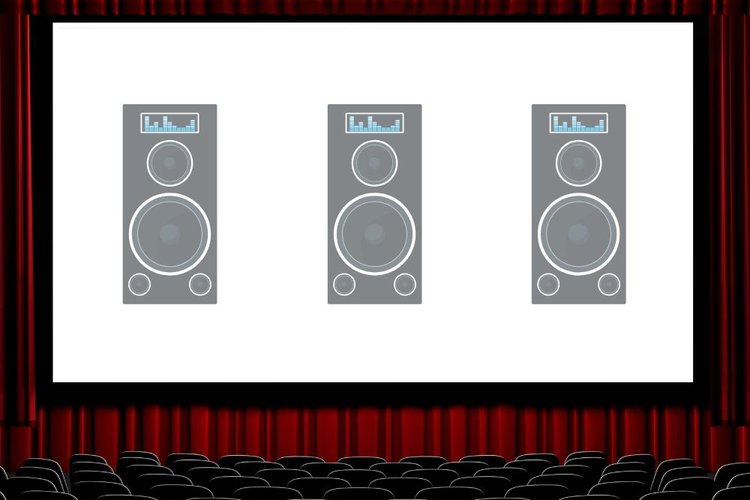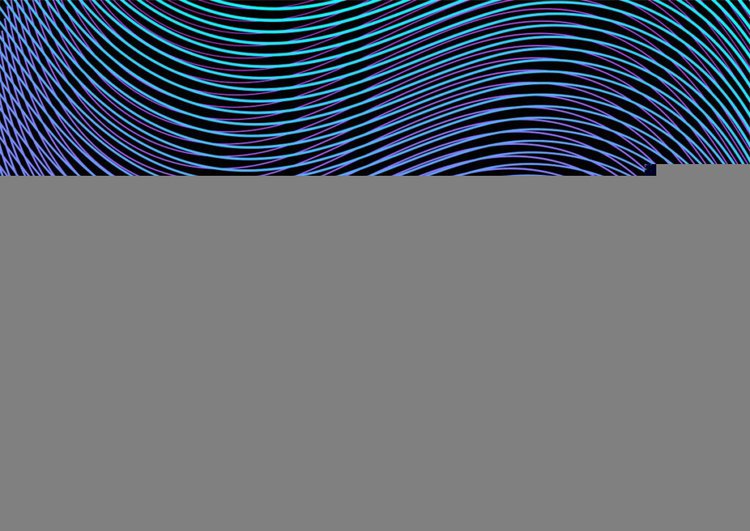Acoustically Transparent Screen: How to Hide Speakers Behind Your Projector Screen

- For optimal sound quality with a projector, consider speaker placement strategies like symmetry, top corners, or center, depending on room size and speaker type.
- Using an acoustically transparent screen allows for speakers, including soundbars, to be placed behind it without compromising sound or visual quality.
- Choose between woven and perforated acoustically transparent screens based on your preference for sound transmission versus image reflectivity, with DIY options available.
Putting your speakers or soundbar behind the projector screen offers a sleek, uncluttered look, but it may sacrifice the audio quality if not done right.
Fear not!
Our guide will show you how to pick the perfect acoustically transparent screen and arrange your audio setup for an immersive experience.
Note: If you want to know about the best quality speaker that can be used with your projector, check here.
Quick Navigation
- What Are the Different Ways of Setting Up a Speaker With Your Projector?
- Can You Put Speakers Behind a Projector Screen?
- What Is an Acoustically Transparent Screen?
- Why Should You Use an Acoustically Transparent Screen?
- Woven vs. Perforated Projector Screens
- Recommended Acoustically Transparent Screens
- DIY: How to Build an Acoustically Transparent Screen Yourself
- Wrapping Things Up
What Are the Different Ways of Setting Up a Speaker With Your Projector?

Speaker setup is very essential in delivering top quality and pure sound from any media player. Missing the right setup can give you undesirable sound irrespective of your sound system.
The choice of your setting is dependent on two major factors. These are:
- The size of the room
- The type of speaker
The list above is an intentional order because it is essential to know the size of your room before purchasing a speaker.
Symmetry
When the speakers and the listener form a triangle, the listener is at the apex of the symmetry. The purpose is to achieve an acoustic symmetry with two speakers. It is achieved by having an equal distance between the speaker and the wall surrounding it.
This type of setting is good for people looking for an equal loading of sound from every corner of the room.
Top corners
This type of sound system setup allows sounds coming from the corners of the room to meet at the center of the room. The sound achieved with this type of setting doesn’t balance with the ear level.
If you intend to use this type of setup, you will require a minimum of four speakers to cover the room. So, instead of using this setting to achieve equal loading of sound in the room, consider the symmetry setup.
Centering
This article is centered around this type of setup. It involves putting your speaker directly in front of you (the audience) and the screen.
In the case where your screen is a projector screen, the speaker can be put behind the screen or in front of the screen.
Can You Put Speakers Behind a Projector Screen?

From the different sound system setups we have considered, it is possible to place your speaker behind your projector screen.
So, if you have the required screen type, you can consider moving your speaker behind your screen.
Is It a Good Idea?
Projector screens are mostly placed at eye level or a little above eye level, which is also at the same level as the ear.
Sound travels in a straight line, so having your speaker behind your projector screen places you at an advantage of sound traveling directly into your ear. Having sound travel directly into your ears has helped you pick every detail of the audio.
I know you are probably thinking of moving your speaker behind your screen to improve the sound. Wait! The type of screen you have will decide if this is a good option for you.
If you have a plane screen, don’t even try this out because you are going to mess up the sound. When sound hits a plane’s surface, it echoes.
There are special screen types that are made for this purpose. This type of screen is known as an acoustically transparent screen.
What Is an Acoustically Transparent Screen?
An acoustically transparent screen is a specially designed projection screen that allows sound to pass through while reflecting light.
Unlike conventional projector screens, these screens enable speakers to be positioned behind the screen, resulting in a sleek and unobtrusive setup.
The screen’s unique construction ensures that sound quality is not compromised while maintaining excellent visual performance.
Why Should You Use an Acoustically Transparent Screen?
Pros
Concealed Speakers: By placing speakers behind the screen, you can achieve a clutter-free and aesthetically pleasing setup. The speakers become virtually invisible to the viewer, creating a seamless integration between the audio and video elements.
Immersive Experience: With speakers positioned directly behind the screen, both sound and video appear to originate from the same source, enhancing the immersive cinema-like atmosphere. This integration creates a more engaging and realistic viewing experience.
Efficient Space Utilization: Acoustically transparent screens allow you to utilize the wall space behind the projector screen to hide speakers, freeing up valuable floor space. This feature is particularly beneficial for those working with limited room dimensions.
High-Quality Materials: Acoustically transparent screens are constructed using premium materials, ensuring optimal visual performance. Although they may be pricier compared to standard screens, the superior setup with great image quality justifies the investment for enthusiasts seeking an enhanced cinematic experience.
Cons
Image Quality: Compared to screens of a similar price, acoustically transparent screens may exhibit slightly lower image quality due to their unique construction. However, the disparity is often negligible when watching from a distance, and the benefits of concealed speakers outweigh this minor trade-off.
Audio Reflection: Despite their acoustically transparent nature, these screens still reflect some sound. This reflection can slightly impact the audio experience, although advancements in screen design have significantly minimized this issue.
Image Reflectivity: Acoustically transparent screens tend to have lower image reflectivity (gain) compared to other types of projector screens. This lower gain can affect the brightness and clarity of the projected image, particularly in rooms with high ambient light. However, proper calibration and adjusting projector settings can help mitigate this concern.
Moiré Effect: The Moiré effect is a visual distortion caused by uneven weaving patterns on the screen.
This effect can be severely annoying, and one avforums user even sacrificed keystone and overscan (two important parameters when calibrating your projector) just to mitigate the Moiré effect.

However, investing in a higher-quality screen with precise and uniform weaving patterns minimizes the occurrence of the Moiré effect.
Alternatively, calibrating the focus and sharpness settings on your projector can help reduce this issue.
Woven vs. Perforated Projector Screens
There are two primary types of acoustically transparent screens: woven and perforated screens. Let’s explore the differences between them.
Woven Screens
Woven screens are made by weaving fabric threads together (with a specific pattern or structure) to create a surface for displaying images.
Due to their larger weaves, woven screens allow more light to pass through compared to the tiny holes of perforated screens.
However, this increased light transmission poses a risk of “double imaging” issues, where light passing through the gaps in the weave creates a faint secondary image or shadow.
To address this concern, many woven screens now incorporate a black panel that absorbs excess light passing through the weaves.
Woven screens excel at allowing sound from behind the speakers to pass through effectively, enhancing audio performance.
Perforated Screens
Perforated screens feature tiny perforations or holes (less than 0.3 – 0.6 mm in diameter) across their surface, typically made of a strong PVC material.
While perforated screens offer better light reflection, which can enhance image brightness and contrast, they are less effective in transmitting sound.
The smaller holes restrict sound transmission, resulting in a slightly compromised audio experience.
However, perforated screens are an excellent choice for environments where image reflectivity is a priority.
Recommended Acoustically Transparent Screens
When it comes to acoustically transparent screens, there are a few top-notch options available in the market. Here are two highly recommended screens:
- 【GET THE RIGHT SCREEN】: 100-inch Diagonal, 16:9 Aspect Ratio. View Size: 49.0" H x 87.0" W....
- 【SHARP & CLEAR IMAGERY】: Moiré-Free screen material; AcousticPro 1080P3, 1.0 Gain. Angular...
- Features a black velvet covered aluminum frame that enhances overall appearance and absorbs...
(Paid Link.)
Elite Screens Sable Frame AcousticPro1080P3 Series is widely regarded as one of the best perforated acoustic screens on the market.
With a diagonal length of 100 inches and an aspect ratio of 16:9, this screen offers a spacious and immersive viewing experience.
The Moiré-Free screen material ensures a precise and clear image display, and it has a gain of 1, which enhances brightness and contrast.
- Wall Mounted Fixed Frame Projection Screen (Overall Size 65.175" Tall x 110.8" Wide) (Viewing Area...
- Acoustically Transparent (Speakers may be placed behind the screen surface) 1.15 Gain White screen...
- 3 1/8" heavy duty beveled aluminum frame wrapped in light-absorbing black velvet material for a...
(Paid Link.)
Silver Ticket Products STR Series 6 is a popular choice for those seeking a high-quality woven acoustic screen.
With a diagonal length of 58.875 inches and a width of 104.5 inches, it provides ample screen real estate for a captivating cinematic experience.
The screen has a gain of about 1.15, ensuring vibrant colors and excellent image reproduction.
DIY: How to Build an Acoustically Transparent Screen Yourself
If you prefer a more budget-friendly approach or enjoy do-it-yourself projects, building your own acoustically transparent screen is a viable option. Follow the steps in the video below to create your acoustic screen.
Wrapping Things Up
In conclusion, setting up speakers with your projector is crucial for achieving optimal sound quality in your home theater system.
Which speaker setup is right for you will depend on factors such as room size and speaker type. Symmetry, top corners, and centering are common speaker placement options, with each offering its unique advantages.
However, placing speakers behind a projector screen is a popular choice for achieving a clean and immersive setup, which can only be accomplished by using an acoustically transparent screen.
It allows sound to pass through while reflecting light, concealing the speakers, and creating a seamless integration of audio and video.
Woven and perforated screens are the two main types of acoustically transparent screens, each with its own characteristics. It is recommended to choose a high-quality screen that minimizes the Moiré effect and balances visual performance with sound transmission.
For those on a budget or interested in DIY projects, building your own acoustically transparent screen is also a viable option.
Duy Anh is a seasoned technical editor specializing in helping readers troubleshoot TV, projector, and Wi-Fi issues. He’s always been drawn to logical problem-solving. His ability to approach matters from various angles with a neutral mindset enhances his technical expertise.



